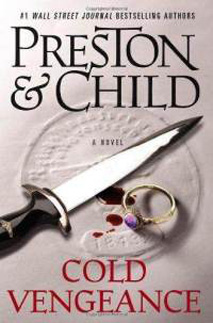There’s a great human monster in “Cold Vengeance” (August, hardcover), the latest Pendergast novel from Douglas Preston and Lincoln Child. He’s Falkoner, a German assassin with an ugly looking mole under one eye who disgusts even his own henchmen for the way he enjoys torturing his targets.
Preston and Child, of course, started off with a more traditional monster in their debut novel “Relic,” and normally that’s what I prefer, but frankly I’m on board for whatever these guys come up with at this point. The Preston/Child-verse, or Pendergast-verse, or whatever you want to call it, keeps getting richer and weirder and more fun. Pendergast — known from the beginning for always producing the requisite instrument from the depths of his pocket-laden coat — remains an unlimited well of surprises without becoming a parody of himself. Almost the entire remainder of the cast is on hand in “Cold Vengeance,” from the reliable detective D’Agosta (although his role is minimized here) to the fascinating Constance (who is 140 years old although she appears to be in her 20s) to Corrie, the small-town goth girl who Pendergast recruited as his assistant back in “Still Life with Crows.”
In the decidedly dark (yet not bereft of humor) “Cold Vengeance” — the second of a trilogy that started with “Fever Dream” — Pendergast is on his most personal quest yet. The authors have upped the ante a notch from when he was tracking down his evil brother, Diogenes. Now he’s tracking down his wife, who he believes is still alive because his wife’s brother, Esterhazy, tells him so just before “killing” him in an early chapter. (I don’t think it’s a spoiler to say Pendergast makes it out of that predicament. Still, I was surprised by the fates of other characters in later chapters.) This is despite overwhelming evidence that Helen is dead; it’s almost to the point that P&C write themselves into a corner. They mostly get out of it, but there are definitely threads left to unravel in the next book.
The authors note that they don’t hesitate to change geography to fit their story’s needs. But real or fake, the settings in “Cold Vengeance” are certainly evocative, starting with quicksand-like swamplands in Scotland where the brothers-in-law go on a deer hunt, and continuing into the creepy Black Brake Swamp in Louisiana that we first visited in “Fever Dream” (P&C have a thing for swamps lately). New York City’s old residential neighborhoods pop off the page as always, and our hero also pays a visit to an old NYC library and its basement archivist, Wren. I can practically smell the musty books and old newsprint as Wren helps Pendergast — who also has decidedly more high-tech allies — dig up ancient clues.
Pendergast uses whatever methods he can as he pursues this mystery. And part of the appeal of P&C’s imagination is that they don’t limit themselves with the boundaries of the current state of science. Their stories are old-fashioned in a lot of ways — if you thought the dispatching of investigative reporter Smithback a few books ago was to pave the way for a new-age hacker, you’re wrong; in fact, the young newspaperman introduced in “Cold Vengeance” is almost apocryphal in the way he pursues his story — Smithback would be proud. And, as noted, the settings are sensory in their realism. Yet there are some truly bizarre sci-fi concepts buried in this ongoing yarn, most notably the inexplicable and fascinating Constance. We get to know her as a person rather than as a mystery here, and it’s about time, but there’s still plenty of mystery left.

Pendergast’s pursuit of his wife is the main arc that leads into the next book, but there’s so much more going on here: Characters, settings, ideas. One of those ideas is that the Nazi Party is still around in some menacing form; like Indiana Jones, I’m not crazy about Nazis, but all topics become 100 times more interesting when P&C are writing about them.
I not only recommend “Cold Vengeance,” but I also recommend its as-yet-unfinished sequel.

